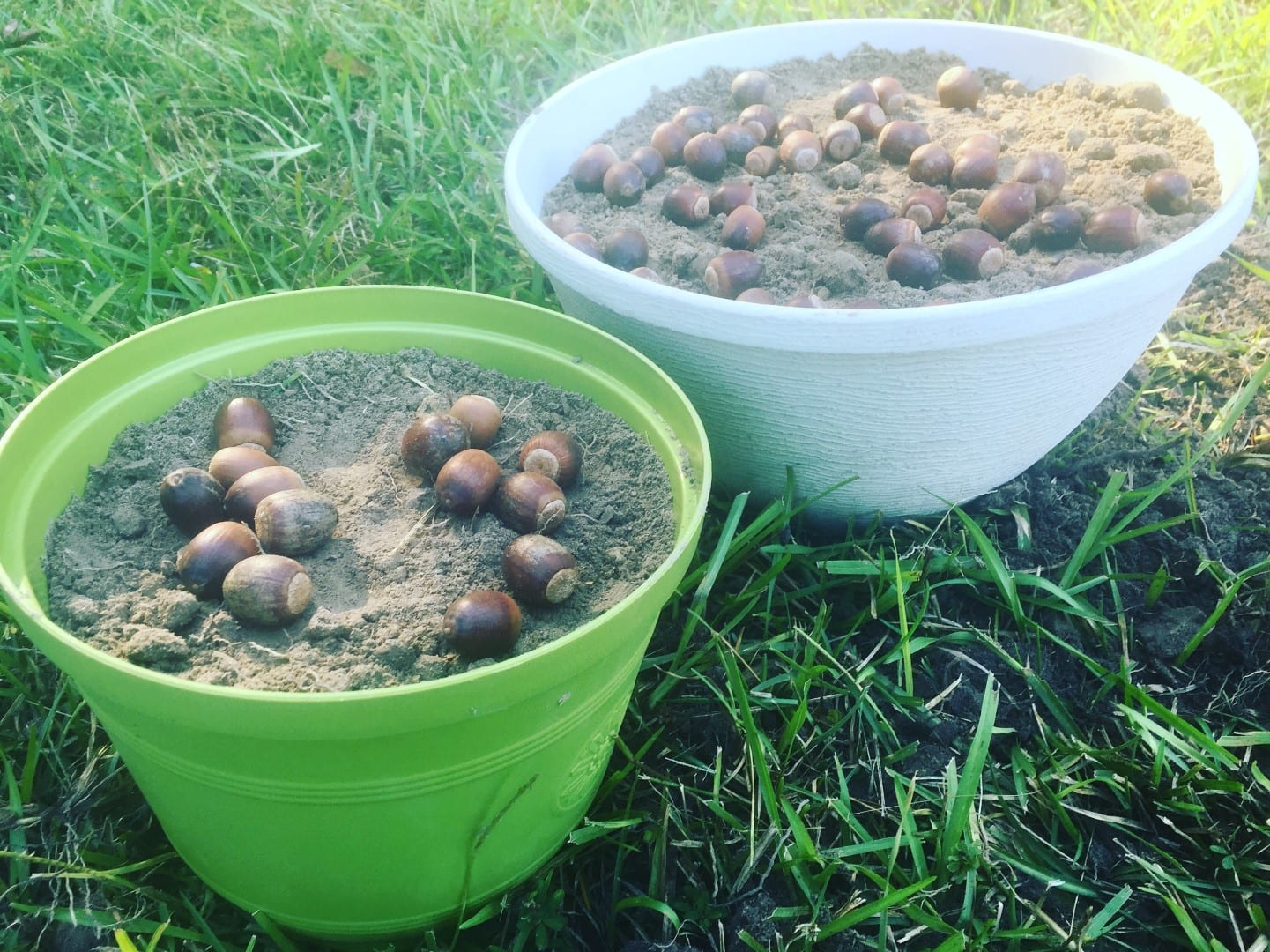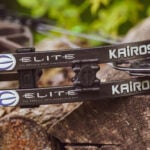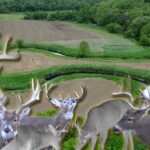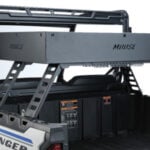Tree plots are probably one of the most over looked aspects of habitat management. Sure, a lot of people may know the benefits of planting trees for wildlife and some may even plant trees. However, very few people put in the time and effort of actually designing entire tree plots for deer. Granted, it is not as simple as putting in regular food plots, but the results can be much greater.
To start, creating soft and hard mass tree plots will greatly increase the holding capacity of your property. For those of you who are not familiar with the term “holding capacity,” it is simply the capacity of deer that your property can hold and sustain. One of the number one things that factor into your holding capacity is food.
Annual and perennial food plots are great for getting food onto your property, but they can only go so far. The average one-hundred pound doe has to eat 9 pounds of food per day. Think of how much clover she would have to eat to reach this requirement, compared to how many apples she would have to eat.
Soft mass fruit is also much sweeter than the plants you are growing in your annual or perennial food plots. Therefore, deer will crave these types of food sources, especially if you are the only one in the area that has fruit trees.
Now that we have gone over a few benefits of tree plots, you may be wondering what steps you should take to start a tree plot project. In this article we will go over everything from how to plant, where to plant, and also how you should choose what trees are best for your situation.
What to Plant
For most, figuring out exactly what types of trees to plant may be the most difficult part of the process. If you are in the northern part of the country, you need trees that have a good cold tolerance. If you are in the southern part of the country, you often need trees that are not susceptible to disease. With the amount of rain fall that we receive in the south and the high humidity, disease can wreak havoc on fruit trees. So, choosing the correct tree for your region is vital.
When it comes to picking trees for my tree plots, I normally have some sort of idea of what I’m looking for, whether it be hard mast trees or soft mass tress. Now, one thing that I like to do is keep my soft mass tree plots and my hard mast tree plots separate. This may sound crazy to some but it actually yields greater results than having them intermingled with one another. Why? It’s all about Ph level.
Most fruit and soft mass trees require a neutral ph level, which is 6.5 – 7.5, to produce high yields of fruit. However, oaks require more acidic soil to produce high yields of acorns. Normally around 4.8 is best. So if you have fruit and acorn trees planted together, the trees will never be able to reach their full potential. Simply because the soil acidity that one would thrive in, would cripple the other, and vice versa.
Another reason I like to keep them separate is that I like to include annual forage into my fruit tree plots. I often plant soy beans and corn in my tree plots during the summer, and brassicas in the tree plots during the winter. If I were to try to plant these annual forages around oaks, the soil ph would be way off and the annual forage would not reach its full potential. So I stick to only planting the annual forage in my fruit tree plots. Most annual forages require the same soil ph levels as fruit trees, so they work well together.
One thing to keep in mind is that you do not want to plant any annual forage under the drip line of your fruit trees. First off, the fruit trees will cast too much shade and the annual forage will not be able to thrive. Secondly, the fruit trees and annual forage will compete for water and nutrients, which will not be good for either plant. Lastly, the annual drilling or disking under the tree will damage the feeder roots and compromise the root system of your tree.
Another great benefit of tree plots is that you can select your trees to where you have at least one type of crop falling for most of the year. You can go from having peaches dropping in the spring, to Swamp Chestnut Oaks dropping acorns into late November, in some cases. Depending on your climate, you want to pick your trees in a way that you have some type of fruit, or nut, falling for as much of the year as possible on your property.
Growing oak saplings from acorns in a controlled environment, such as a pot, is a great way to increase the germination rate.
Once you have decided whether you are planting a hard mast or soft mass plot, the next step is picking the exact types of trees you want to plant. When it comes to picking the exact tree for my climate, I call the folks over at Mossy Oak Nativ Nurseries. They can tell you exactly which tree will be good for your area, as well as sell you the tree and ship it right to your door. Below I will lay out a few different tree types that I have experience with in numerous different climates. These are a great place to start when choosing which trees are best for you.
Pears
Tend to thrive well in fairly wet areas.
Drop in early fall: Anjou, Bartlett, GioVan, Doc’s Special, Flemish Beauty, Kieffer, Potomac, Magness, Shenandoah, Burford, and Stacey
Drop in late fall: Big Mama, Trophy, Gallway
Persimmons
Blue, Craggs, Dollywood, Evelyn, Janet, Killen, Miller, and Yates
Apples
Ripen early: Centennial, Liberty, Enterprise, Rome, Horse, and Magnum Bonum
Ripen later: Honeycrisp, Arkansas Black, Goldrush, Blacktwig, and York
American Chestnut
Chestnuts have more carbohydrates and contain 10% more quality protein than acorns. They also contain no tannin which is why deer will crave and seek out chestnuts over acorns.
Oaks
White Oaks- There are several different types of white oaks you can choose from. However, no matter which type you choose, it holds true that white oaks contain substantially less tannin than red oaks. This will cause them to be more attractive than the red oaks in your area.
Red Oaks- Although red oaks have higher tannin levels than chestnuts and white oak trees, they do have a higher fat content. In areas of severe cold, this will help deer survive the winter.
These are by no means the only trees you should consider. This is simply the types of trees that I have had success with. No matter what type you choose, diversity is key. Diversity will help ensure pollination and improve crop yield. It will also make your tree plots more attractive to the wildlife, so mix it up.
Ordering or Transplanting
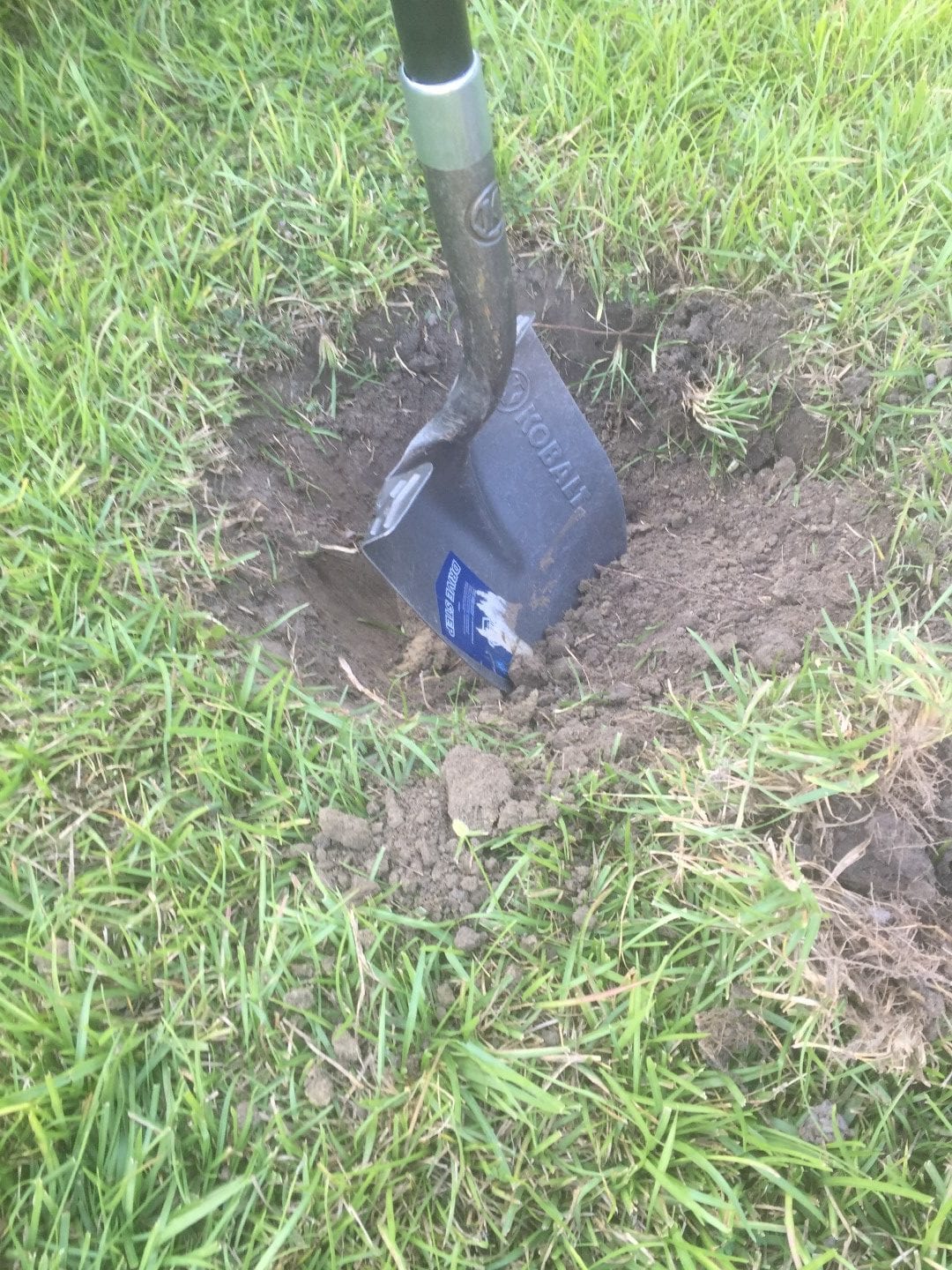
Once you have chosen your planting site, be sure to dig the hole for the sapling slightly bigger than the root ball.
Once you have decided on the type of tree you want to plant, it’s time to order the trees. Now, if you have selected a tree that happens to be common in your area, you might try digging up and transplanting a sapling. When transplanting a tree, be sure not to damage the root ball and dig up as much of the root system as possible. Depending on the size of the sapling, I like to dig 1-3 foot off of the base of the tree. This will help ensure the survival of the tree.
Whether you choose to order or transplant your trees, it is best to do so during the winter. Trees store more energy in the root system during the winter. So planting them while they have this energy stored in the root system will help ensure their survival.
Once you have ordered your trees, it is best to get them in the ground as soon as possible. If you cannot get them in the ground right away, be sure to keep them watered diligently. If the root system dries out, the sapling will die. When transplanting saplings yourself, I recommend digging them up and planting them in the same day. This will help ensure the root system does not have a chance to dry out.
When you call to order your trees, you will have an option between containerized saplings and barefoot saplings. Barefoot saplings mean that they were dug up out of the ground and transplanted into the container for shipment. Containerized saplings mean that they were planted in the container as a seed and have grown in the container thus far in their life cycle. Barefoot saplings will be cheaper, however; containerized saplings tend to have a higher survival rate.
Planting your Trees
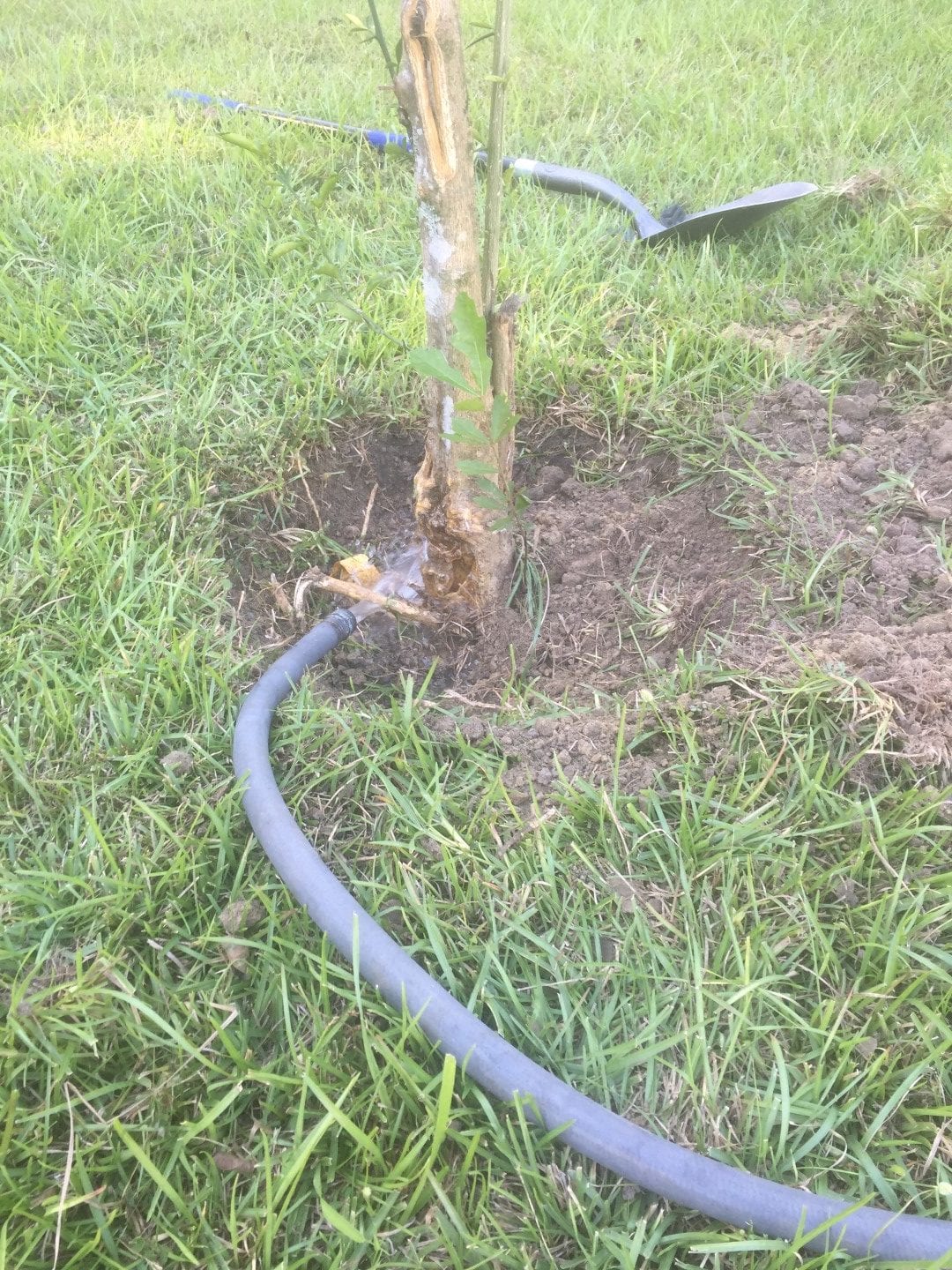
Watering in the sapling as you pack dirt around the root ball will help cut down on suture settling and ensure good root to soil contact.
Once you have chosen your planting site, be sure to dig the hole for the sapling slightly bigger than the root ball. Now that you have ordered your trees, or picked out the saplings that you wish to transplant, it is time to get them in the ground. The downfall that I see most commonly in tree plots is tree spacing. This can be very crucial for the trees survival and making the plot huntable.
If you plant the trees to close, they compete with each other for water and nutrients. As well as make it very difficult to hunt. If you plant them to far apart, they struggle to help pollinate one another and your crop suffers. For soft mass trees, I recommend spacing them about 20 feet apart. For hard mass trees, I recommend spacing of about 30 feet. This will help ensure good pollination as well as make it easy to harvest deer in the plot.
Planting depth is also very crucial when planting any type of tree or shrub. You want to be sure you don’t plant the tree to deep or the soil will hold moisture around the base of the tree, causing the base to rot. You also don’t want to plant the tree to shallow, or the root ball will dry out, killing the tree. When planting trees I recommend leaving about ½ an inch of root ball sticking out of the ground. For instance, when you pull a tree out of the container, you will have a ball of dirt surrounding the root system. Do not plant the top of the dirt ball even with the surface of the soil. Leave it sticking about ½ an inch above the soil surface. That should be plenty deep enough for the root ball not to dry out but also not too deep for the base of the tree to be in the soil.
The first year of the saplings life is the most crucial. If it gets to dry it will die. If the wildlife damage it, it will die. So there are a few safety measures you can take to help prevent both of these situations.
To help prevent wildlife damage and to ensure the tree develops a correct growth pattern. I recommend placing a tree tube on all of your trees. The tree tube will wrap completely around the sapling, leafs and all. This will keep the wildlife from damaging the tree and well as force the tree to grow upward instead of the limbs growing out and drooping down. Once the tree has grown too big for the tree tube, the tree tube will simply bust off, or you could remove it yourself.
In order to keep the root system as moist as possible, I also recommend placing some type of plastic or weed cloth on the ground directly around the tree. This will also help to keep unwanted grasses and weeds from competing with your sapling. Personally, I place the plastic around the tree in about a 2 foot diameter off the base, while being sure to leave it about an inch off of the base of the tree. In times of drought, I will come in with a tank and water hose to water my trees. I will simply place the hose under the edge of the plastic and let it run for 3-5 minutes, or until I feel that the root system is good and saturated. Keeping the tree watered at all costs is very vital to its survival.
Caring for your Trees
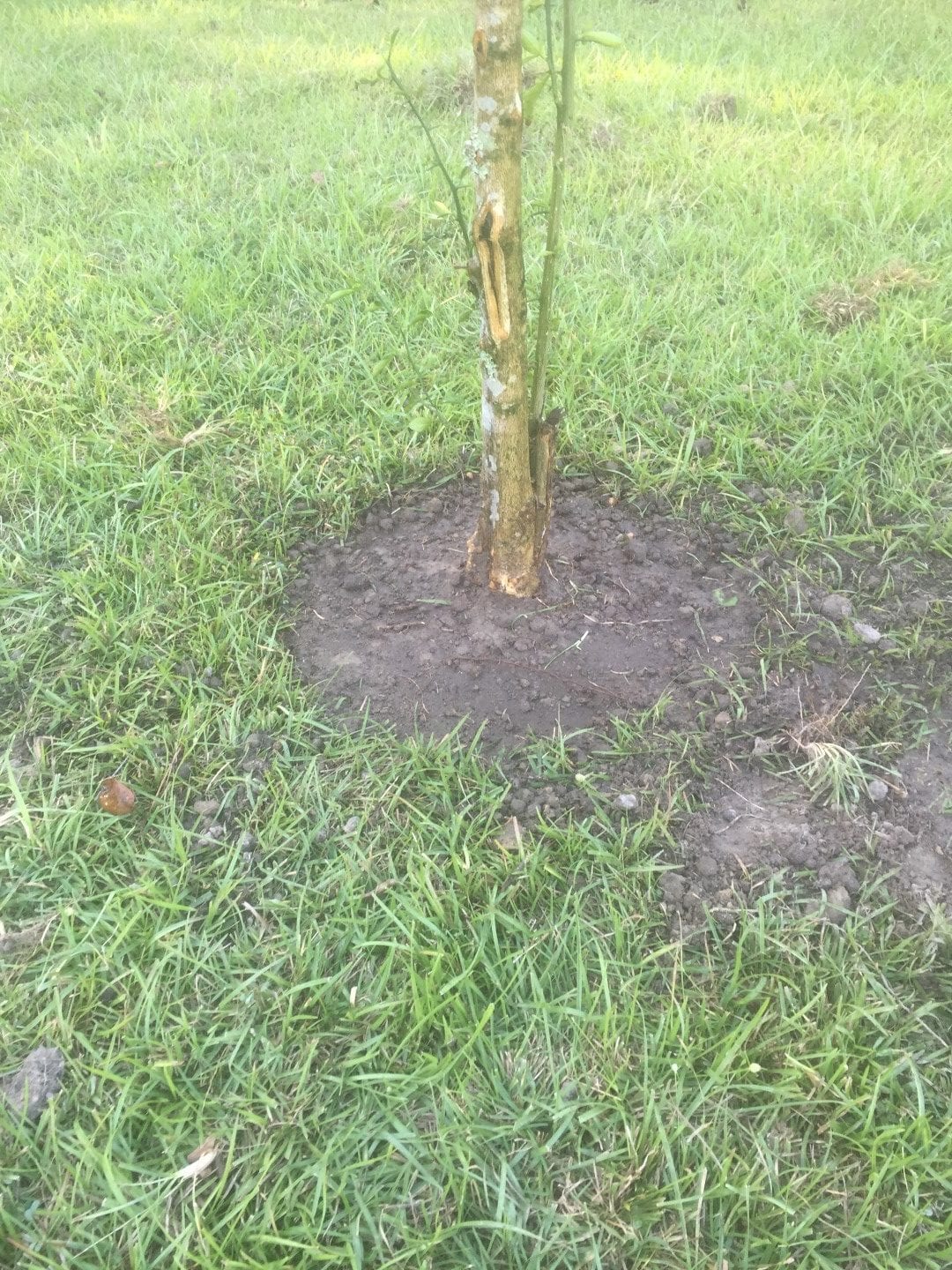
Be sure to keep the area under the drip line of the sapling free of competition and water it regularly.
This will help ensure that it establishes well at its new site.Now that you have your trees in the ground, the hard part is over. Now you just need to keep up with some simple maintenance to help ensure your trees make it to maturity.
The most common question I get is on fertilizing your trees. When to fertilize your fruit trees and how much to apply, is critical. Too much fertilizer and you can damage the root zone of the tree. Too little fertilizer and you won’t receive the results you are looking for.
Always remember; never fertilize your fruit trees after July. This will cause the tree to push out new growth and use up the energy it was storing in its root system for winter. Fertilize the tree in February the first year it is planted. On the first year, one cup of fertilizer is usually sufficient. If you notice any yellowing or nutrient deficiencies, apply another cup of fertilizer in May. Follow this same process the second year.
After the second year, a good rule of thumb is one pound of fertilizer per inch of trunk diameter. Follow this process for the remainder of the trees life. Be sure to spread the fertilizer evenly within the drip line of the tree. In the past, it was recommended to create a ring of fertilizer around the base of the tree, about 6 inches off of the trunk. However, this is known to cause root damage and I do not recommend it.
Another vital part of caring for your trees is eliminating competition, which we touched on earlier. Studies have shown that trees where the competition has been removed are 20-30% larger than trees where the competition was not removed. Spraying under the drip line of the tree with Glyphosate is the best way to ensure that no grasses or weeds are competing with your trees. Don’t worry, Glyphosate has no soil activity. Which means that it will only kill foliage that it directly hits, so it will not damage the tree by spraying the ground underneath it.
Pruning the tree is also quite simple. Start by pruning any dead or diseased limbs. If you believe a limb is diseased, be sure to spray your pruning shears with rubbing alcohol after each cut. This will ensure that you do not spread the disease. You also want to prune any sprouts or ‘suckers’ growing out of the base of the tree.
The next step of pruning your trees is pruning them to allow air flow and sunlight into the canopy. Start by removing any branches that grow toward the center of the tree, any branches that grow downward, and any branches that cross paths with one another.
The final pruning step is simply pruning back the outermost growth of the tree so that the branches become shorter and thicker. Allowing the limbs to grow longer and thinner will cause the limbs to snap under the weight of the fruit. Ideally, you want to 20 to 30 percent of last year’s growth.
To some, this may be over kill when it comes to managing deer habitat, but to me, this is a gold mine. Anything you or I can do to provide our whitetails with more food, we should be doing. It’s our jobs as conservationists to give back to the wildlife and the environment. Help nature provide any chance you get. Happy growing.

